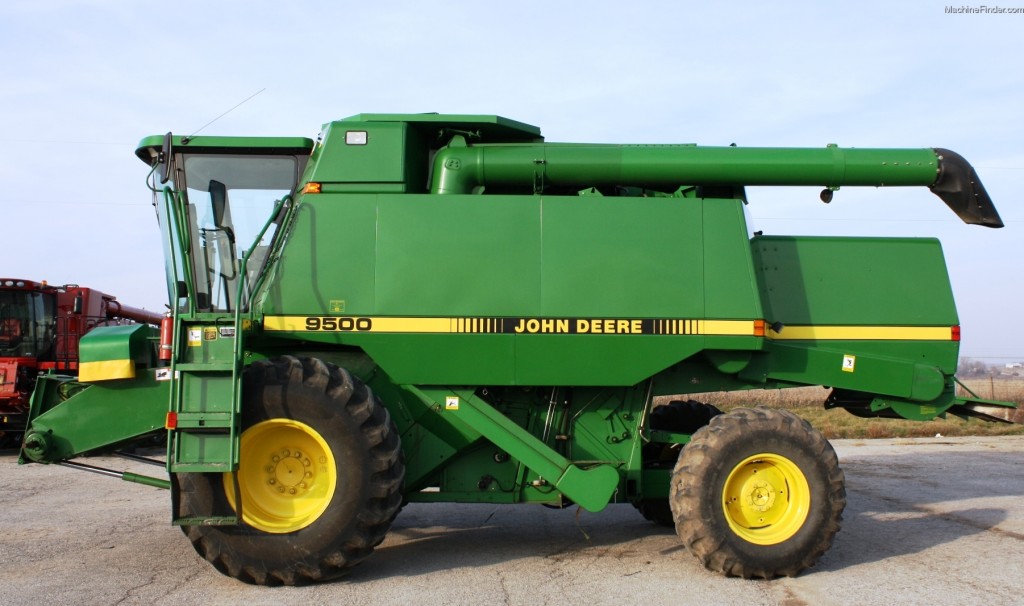Over the years, many improvements in technology and design were made to John Deere 9000 Series Combines. These changes, which were incorporated to provide farmers with full harvesting capabilities, included everything from increased engine power to added grain handling options.
We thought it would be interesting to take a trip down memory lane, and explore the key model changes that were made to John Deere 9000 Series Combines that have led us to current combines on the market. Let’s take a look at the complete transformation that took place from 1990 to 2005.
1990-1993 Model Changes
During this short span of time, the John Deere 9000 Series Combines’ horsepower increased dramatically across all models, with the 9400 increasing from 155 to 185 hp, and the 9600 increasing from 200 to 260 hp.
In 1990, the grain tank loading auger flighting of these machines was strengthened and the chaff spread was made available. After which, in 1991, all models were improved with increased cooling capacity and drive torque of the feeder house slip clutch. A breather was added to the Posi-Torque cylinder drive along with a new fuel tank and filler cap to progress sealing ability.
In 1992, New Generation Engines were introduced in the 9500 and 9600 models, while automatic speed control for corn heads and row crop heads were made available for all models. The series’ feeder house pivoting was then improved and the HarvesTrak was made a standard feature in 1993.
1994-1997 Model Changes
From 1994 to 1997, many design and technological features were added to the John Deere 9000 Series Combines to help farmers reach higher production and better collect data on the field.
In 1994, hoses were implemented to replace previously used steel lines from the hydrostatic pump to the motor. A pressure fan was also added to the cab air system, and a grain curtain was also included in the design. Later, in 1995, hydraulic adjustable deck plates were made available for the 90 Series Corn Head, while rubber belted tracks were also initiated across all models.
1996 was a meaningful year for John Deere, as the 4435 Combine was discontinued, marking its last model. However, it was also during this year that the 9000 Series’ walker bearings lube interval was increased from 50 to 200 hours. Perforated cylinder filler plates and seat belts were also added to all machines.
When GreenStar was offered as an option for factory install in 1997, farmers had what they needed to increase productivity, efficiency, and profitability. Two new choppers were also made available, including one fine cut and one fine cut widespread.
1998-2001 Model Changes
In 1998, an enhanced cleaning system was added to all John Deere 9000 Series Combines, along with a dual-display tachometer and full-body side shielding. Additionally, the air flow feeder house system was made available across all models. But perhaps the most noteworthy feature was the innovative PowerTech engines, providing increased power for all of these state-of-the-art machines.
In 1999, the John Deere factory-installed spare knife and storage brackets on all of the 9000 Series cutting platforms. During this time, the 50 Series Combines hit the market, featuring many new enhancements.
1999 was a very significant year for John Deere, as it marked the final year the 9000 Series Combine was in production. But despite closing this chapter, the company continued on its mission to provide top-notch equipment, as the STS (Single Tine Separation) had been in production for more than 10 years prior to its launch.
We hope this has provided you with a special look into the evolution of John Deere 9000 Series Combines and a better perspective on how we have come to today’s combine technology.
If you have any questions about any of John Deere’s combine models, you can contact your local John Deere dealer.
If you enjoyed this post or want to read others, feel free to connect with us on Facebook, Pinterest, or Twitter!
